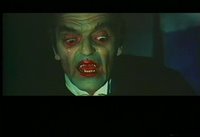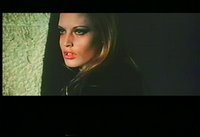 Directed by: Jess Franco
Directed by: Jess Franco
Release Date: 1972
Contains spoilers
Let’s get it on record, I like Jess Franco movies. It is not just the exploitation factors but an intangible something within the films. As surreal, badly plotted (if plotted at all), strangely shot and poorly acted as they might be there is a certain something.
Dracula Prisoner of Frankenstein is one of the most bizarre I have seen, which is odd given that, on the surface, it is simply a monster mash. Firstly there is a distinct lack of the exploitation that Franco is famous for, you will not see a naked bosom in this - never mind a sex scene. The most you will see is some fairly unrevealing lingerie on a cabaret singer (Josyane Gibert). The surrealism of Franco is also lacking, in the traditional sense, the surrealism comes in the fact that there is barely any dialogue and nothing of real plot substance until 40 minutes into the movie.
The plot, as far as I could ascertain, essentially runs like this. Dracula (Howard Vernon) is terrorising the locale, as Dracula is want to do.  The look of Dracula seemed familiar to me and it wouldn’t actually surprise me if Franco’s vision didn’t, at least a little, inspire the makeup artists who created the look of the Count in The Legend of the Seven Golden Vampires, two years later.
The look of Dracula seemed familiar to me and it wouldn’t actually surprise me if Franco’s vision didn’t, at least a little, inspire the makeup artists who created the look of the Count in The Legend of the Seven Golden Vampires, two years later.
Jonathon Seward (Alberto Dalbés) visits one of Dracula’s victims. Now there is an interesting moment here where he appears to plunge a needle into the girl’s left eye (a move that causes the light to fail). I say appear as I re-watched the scene several times and it wasn’t that clear, and without dialogue there wasn’t chance of explanation, but it is a manner of disposing of the undead used in Black Sunday. Seward takes his buggy up to the castle and finds Dracula’s coffin and disposes of him in a most bizarre manner.
Dracula lies, eyes wide open; Seward takes a stake, which looks little more substantial than a thick twig, and hammers it gently in with a reflex hammer (no blooming great mallet here). The stake falls, not in anything, as Dracula dies, for he transforms into a dead bat.
It appears that Seward has saved the day but he has a patient (I assume from the cast list, as it isn’t clear in the film, that she is Maria played by Paca Gabaldón) who seems to react strongly to the forces of evil. She acts as a psychic barometer, very much in the way Renfield did in Dracula and has a reaction despite the fact that the Count has been disposed of. Dr Frankenstein (Dennis Price) has come to town.
Frankenstein and his deaf/mute assistant (Again not clear due to lack of  dialogue but I’m assuming Morpho played by Luis Barboo) set up shop in Dracula’s castle. It is interesting how Franco deliberately (?) juxtaposed technology. Whilst Frankenstein mentions Seward’s science later it is clear that the innocent have no technology. They use horse drawn buggies and their homes are candlelit, whereas Frankenstein has a motor vehicle, plus his lab and electric light bulbs. Frankenstein reenergizes his monster (Fernando Bilbao) and sends him to kidnap the cabaret singer.
dialogue but I’m assuming Morpho played by Luis Barboo) set up shop in Dracula’s castle. It is interesting how Franco deliberately (?) juxtaposed technology. Whilst Frankenstein mentions Seward’s science later it is clear that the innocent have no technology. They use horse drawn buggies and their homes are candlelit, whereas Frankenstein has a motor vehicle, plus his lab and electric light bulbs. Frankenstein reenergizes his monster (Fernando Bilbao) and sends him to kidnap the cabaret singer.
They use her blood to resurrect Dracula in a most effective and yet bizarre resurrection. The blood is drawn by transfusion methods, to fill a bell jar in which the bat corpse is kept. Franco shows us a live bat in a jar licking up the “blood”. When the bat is almost covered Frankenstein uses his equipment and resurrects the Count. The fact that blood was not enough was bizarre enough, but the use of the equipment is both unusual and means that Dracula is now Frankenstein’s slave. Morpho then disposes of the cabaret singer in a furnace but not before he fondles, quite disturbingly, her corpse.
So, why has Frankenstein resurrected Dracula? It seems he is creating a shadow army with which to rule the world. No more explanation is given. He has Dracula vampirise Maria (which puts her, due to the use of the lab, under his control as well) in order to take Seward’s weaponry away (remember she is a psychic barometer) though why he didn’t just have Seward killed is another question altogether – though the monster does beat him. Unbeknown to him, however, there is another vampire girl (Britt Nichols) who is not under his control.
 A gypsy woman, Amira (Geneviève Robert), who is dying having been attacked by the vampire girl, binds Seward’s wounds and tells him that it is his courage that will defeat the evil but, when the moon is full, the wolfman (Brandy) will come and help him. This is pointless as Seward does bugger all from now on but stand around, miles from the castle, and look broody. Meanwhile Dracula and Maria kill a husband and wife, presumably to be vampirised as they end up in the lab – though we never see them in action.
A gypsy woman, Amira (Geneviève Robert), who is dying having been attacked by the vampire girl, binds Seward’s wounds and tells him that it is his courage that will defeat the evil but, when the moon is full, the wolfman (Brandy) will come and help him. This is pointless as Seward does bugger all from now on but stand around, miles from the castle, and look broody. Meanwhile Dracula and Maria kill a husband and wife, presumably to be vampirised as they end up in the lab – though we never see them in action.
We then have the monster fight and it is bizarre. The vampire girl kills Morpho and then the wolfman attacks Frankenstein’s monster (a fight the monster eventually wins).  As Frankenstein watches this he is attacked by the vampire girl. He electrocutes her in his equipment, burning her in bat form. Incensed at the attack he gets a pike and, because of disloyalty, kills Dracula and Maria in their coffins (and presumably the husband and wife if they were turned). He then uses his equipment to kill the monster and declares he will find another way (of dominating the world I assume). I say this is bizarre as he and his were attacked by a couple of monsters not under his control and so turned on those under his control, men with such insecurity problems are unlikely to ever achieve world domination.
As Frankenstein watches this he is attacked by the vampire girl. He electrocutes her in his equipment, burning her in bat form. Incensed at the attack he gets a pike and, because of disloyalty, kills Dracula and Maria in their coffins (and presumably the husband and wife if they were turned). He then uses his equipment to kill the monster and declares he will find another way (of dominating the world I assume). I say this is bizarre as he and his were attacked by a couple of monsters not under his control and so turned on those under his control, men with such insecurity problems are unlikely to ever achieve world domination.
Seward and a mob of gypsies enter the castle and find skeletons in the vampire coffins (why they became skeletons and not bats this time I don’t know). He holds up a crucifix and gives thanks to God – fin.
As you can see the plot is an incoherent mess with motivations flying all over the place without any real form of explanation. Again this will have a lot to do with lack of dialogue and, probably, because key bits of the film ended up on the cutting room floor. I say this because the story does seem to lurch forward bizarrely at the end. Up until the fight the film has been languid, the fight occurs in the last 5 or 10 minutes.
Franco has put in some great shots, especially of the castle, and yet marred it with shaky camera work at times, ridiculous zooms and a complete disregard of day and night. In fact it seems to have been that the film has been shot whenever Franco felt like it - day and night being a minor inconvenience. There is no real acting to speak of, with lack of dialogue we simply get reaction shots, these mainly consist of women screaming and don’t expect any real reaction from Frankenstein and even less from the weirdly bug eyed Dracula who seems to have been resurrected sans brain and personality.
Yet there are some fascinating concepts daring to poke through the swamp and because of this it is a difficult film to give a score to. Franco tried to shoot this as a straight movie, missing much of his idiosyncrasies, and yet they are still there, lurking in the shadows. It is an incoherent mess in places and yet there are great ideas also, that no one other than Franco would have come up with. This is not a great film to introduce a viewer to Franco and is hard work for those of us who love (despite ourselves) his movies. 3 out of 10. To a degree I believe I have been overly generous, despite the interesting aspects in the film, as to me the best part of the movie was the DVD cover.
The IMDB page is here.
Wednesday, September 13, 2006
Dracula Prisoner of Frankenstein - review
Subscribe to:
Post Comments (Atom)
















1 comment:
3 out of 10 is very generous here, methinks.
Post a Comment